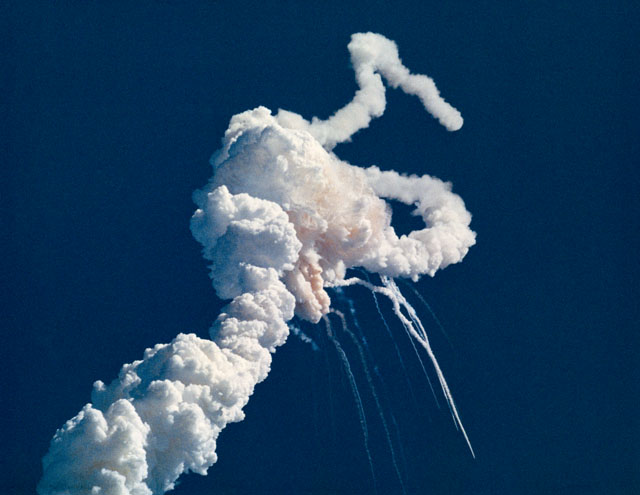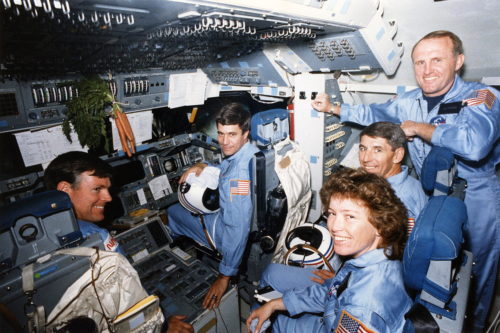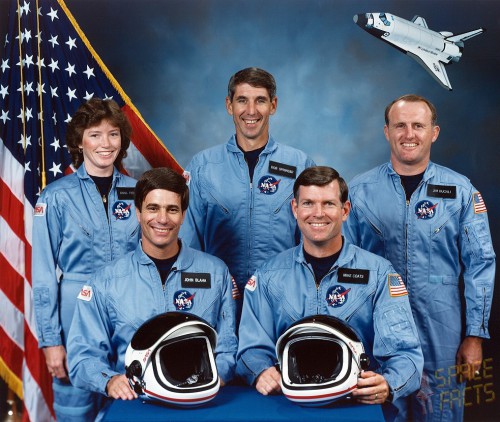
The beginning of the end of Mission 61H came on 28 January 1986, when Challenger and her crew were lost, just 73 seconds after liftoff. As described in yesterday’s history article, the flight was intended for launch aboard Columbia in June, carrying a payload of three communications satellites and a seven-strong crew, including the first astronauts from Britain and Indonesia. “I was out at Base Ops at Ellington [Field], getting ready to fly in a T-38,” recalled Pilot John Blaha of his movements on the morning of the tragedy. “As soon as the Challenger launched, I was going to walk outside and fly down to Kennedy and they were going to put some data tapes in the backseat of my T-38 and I was going to fly it back here. That was my job on the Challenger flight, so I was literally standing out there. I saw the launch on television.”
Mission 61H Mission Specialists Anna Fisher and Jim Buchli were at JSC, at a robotics training session in the Shuttle Mission Simulator (SMS). The pair were up on the flight deck, rehearsing their duties, and occasionally Fisher asked her instructors if the launch was still on schedule. “When they came out of the ten-minute hold at T-9 minutes, I asked them to freeze the sim and we went down to the conference room to watch it,” she recalled. “We were watching it on TV. As soon as it happened, Jim and I looked at each other and said ‘We’re going to cancel’, because we knew immediately what the outcome was.” The 61H crew—Commander Mike Coats, Pilot John Blaha, Mission Specialists Bob Springer, Anna Fisher, and Jim Buchli, and Payload Specialists Nigel Wood of Britain’s Royal Air Force (RAF) and Pratiwi Sudarmono of Indonesia—were stood down, as were the other shuttle crews scheduled to launch in 1986.
Nigel Wood was back in Britain at the time of the Challenger accident. “It was a horrible moment,” he recalled in a 2010 interview. “There was the human loss: you knew your mates had been killed, and it was one of those moments, too, when you knew that history had changed dramatically … for NASA, for the United States, for the space program.”
In the months following the trauma of Challenger—which Blaha described to the NASA oral historian as a time that “tore my heart out”—the shuttle program and the space agency itself came under an intense media and political spotlight as former Secretary of State William Rogers oversaw a commission to investigate the cause of the disaster. Numerous technical, human, and cultural failures were identified, one of which pertained to Mission 61H. In his testimony before the Rogers Commission, astronaut Hank Hartsfield made reference to Coats’ flight in terms of inadequate simulator time for training. “Had we not had the accident, we were going to be up against a wall,” he explained. “61H … would have had to average 31 hours in the simulator to accomplish their required training. That is ridiculous. For the first time, somebody was going to have to stand up and say we have got to slip the launch, because we are not going to have the crew trained.” Training was affected by the presence of only two shuttle simulators at JSC, capable of supporting crews for no more than 12-15 missions per annum. “The flight rate at the time of the accident,” read the Rogers Commission’s final report, “was about to saturate the system’s capability to provide trained astronauts for those flights.”

Within weeks of the loss of Challenger, the owners of the 61H satellites were already looking to other launch service providers to get their payloads into orbit. It was evident that the shuttle fleet would be grounded for at least 18 months. As early as April 1986, the British MoD was in talks with Arianespace to fly Skynet 4A and 4B and Flight International noted that the opportunities for “passenger” payload specialists, such as Nigel Wood, would likely be decimated when the shuttle fleet returned to regular operations. With a fleet of only three surviving orbiters, NASA was keenly aware that it would struggle to attract commercial interest. The dispute over who—Arianespace or NASA—would launch Skynet 4C continued until the very eve of the Challenger disaster, with Arianespace including the satellite in its payload manifest, before a decision had even been made, and NASA offering the British a generous launch price and a “free” ride for a third British payload specialist. However, the post-Challenger down time sounded the death knell for flying Skynet aboard the shuttle. By the end of 1986, Skynet 4B and 4C had both been officially manifested aboard Ariane 4 boosters, with the slight chance that Skynet 4A might still be launched aboard the shuttle in 1989 hanging by a thread.
However, that thread grew ever thinner. By the time the first post-51L shuttle manifest was published in October 1986—detailing a “Return to Flight” no sooner than February 1988—it featured a multitude of NASA or Department of Defense payloads. By the time NASA published its March 1988 shuttle manifest, Skynet 4A had slipped to STS-49, no earlier than April 1991. Significantly, its crew complement was listed as just five members, implying an all-NASA “core,” with no payload specialists. …
Skynet 4A was ultimately launched, not aboard an Ariane 4, but aboard the first Commercial Titan III mission from Space Launch Complex (SLC)-40 at Cape Canaveral Air Force Station, Fla. Meanwhile, Indonesia’s Palapa-B3 was renamed “Palapa-B2P” and was shifted onto a Delta expendable booster and eventually flew from the Cape’s SLC-17B in March 1987. The case of Westar VI-S was bound to the heavy financial losses suffered by Western Union, which prompted it to sell the entire satellite fleet back to prime manufacturer Hughes in 1988. The manufacturer completed the fabrication and testing of Westar VI-S, after which it was renamed “Galaxy VI” and launched atop an Ariane 4 vehicle from the Guiana Space Centre in Kourou, French Guiana, in October 1990.
As for the remainder of the 61H crew, the all-NASA “core” remained together for a 32-hour simulated shuttle flight (known as “61M-T”) on 29 October 1986. “Our crew was lucky,” remembered John Blaha. “About two months after [Challenger], we were assigned as a prime crew to train for a simulated launch. The idea was to keep the whole training system running. We had a two-day simulation mission, then we actually went back into training again.” They also performed a 56-hour simulation at JSC in April 1987, confidently expecting that they would remain together as a crew in the post-Challenger era. In March 1988, most of the former 61H crew was reassigned to STS-29, which was scheduled for launch in the spring of 1989 to deploy NASA’s fourth Tracking and Data Relay Satellite (TDRS-D). Years later, Blaha reflected that his work on the October 1986 and April 1987 simulations had prepared him for his first shuttle mission. “I felt like when I launched on STS-29 that I’d been through my third training flow,” he said, “which meant I really felt very comfortable.”

Less fortuitous was the fact that STS-29 lost Anna Fisher, who gave birth to her second child in January 1989 and later took an extensive leave of absence from the astronaut corps to raise her young family. When Chief Astronaut Dan Brandenstein told Coats, Blaha, Buchli, and Springer in March 1988 that he had been assigned to STS-29, but that Fisher was not on the crew, it came, in the words of Blaha, as “a big downer.”
In his words to the NASA oral historian, the loss of Fisher significantly changed the crew dynamic. “Anna was the MS2 [the flight engineer] and I used to smile going through the training briefings, because there was no question Anna was ten or 20 IQ points above the [rest] of us. She would sit there and I could tell by her eyes when someone explained something to us, she knew within about ten seconds; she had it. We were all scratching our heads and, maybe 15 minutes later, we would catch up. You could tell by her expression, but she was so nice about it, because she wouldn’t say anything.” Periodically, during simulations, Blaha would hear a quiet voice in his earpiece. It was Fisher: “John, do this switch now!” “And that was her, just trying in a very nice way to tell you that you’ve got to do this now or you’re going to screw it up. I learned whenever I heard that, just do what she said, don’t try and ask why.”
By his own admission, the loss of Fisher took him “a while to get over; probably six months to even a year.” Also assigned to STS-29 to complete the five-member crew was civilian physician Jim Bagian. “We were like two groups of people,” said Blaha. “Anna was the one who formerly had integrated us, and she was now gone … but we were a good crew and we had a good mission and did well.”
Launch of STS-29 was postponed from its original date of 18 February 1989, in order to permit engineers to replace faulty liquid oxygen turbopumps on Discovery’s three main engines. A new target of 11 March was also scrapped when a Master Events Controller (MEC) failed during checks and had to be replaced. Finally, the five astronauts left the Operations and Checkout Building for Pad 39B on the morning of the 13th and were strapped into their seats. Ground fog and high upper-level winds delayed the launch for almost two hours … which proved particularly uncomfortable for the crew, since they were all lying on their backs with their legs elevated. “Mike Coats had a very bad backache,” Blaha remembered, “so he finally decided he had to unstrap, because we were being delayed for such a long time. We ended up laying on our backs … very close to the five-hour limit, before we launched. Mike unstrapped and actually … was laying on his side and then he’d lay on the other side.” At length, Discovery thundered into space at 9:57 a.m. EST.

The three rookies of STS-29 adapted well to their new environment. For his own part, John Blaha experienced none of the worrisome signs of space sickness. “From that first millisecond that we were in zero-G, I never felt bad,” he told the NASA oral historian. He would ultimately fly five times, including a long-duration mission to Mir, and proved vocal of his profound love of space travel. “After each of his flights,” Bryan Burrough wrote in his controversial book, Dragonfly, “he always said he felt like running back to the launch pad and climbing back onto the next rocket.”
Within hours of reaching orbit, at 4:10 p.m. EST on 13 March 1989, the TDRS-D payload was successfully deployed into space. The next few days of the mission were spent focusing on middeck and other experiments: a pair of student investigations, involving chicken eggs and four live rats, a demonstration heat pipe concept for Space Station Freedom, and protein crystal growth and plant growth studies. STS-29 flew for five days, touching down at Edwards Air Force Base, Calif., at 6:35 a.m. PST (9:35 a.m. EST) on the 18th.
The landing brought both STS-29 and, in part, the pre-Challenger flight of Mission 61H, full-circle. Four members of the old 61H crew participated in STS-29 and all four of them—Coats, Blaha, Springer, Buchli—would go on to make at least one additional shuttle mission. By the end of their respective astronaut careers, Blaha would have flown five times, Buchli four times, Coats three times, and Springer twice. For Anna Fisher, her lengthy leave of absence ended in February 1996, when she returned to the astronaut office. Since her return, she has served in several management positions, including Chief of the International Space Station (ISS) Branch. Today, Fisher remains the only member of the old 61H crew still based within the astronaut office.
As for the two other members of the 61H crew, Nigel Wood returned to his former duties in the British military, as did his three fellow Skynet payload specialist candidates. He subsequently joined the RAF press team and served as chief test pilot at the Empire Test Pilots School in Boscombe Down, Hampshire, later in his career. He retired from the RAF as an air commodore in 2003 and later established a design and photography business in Salisbury, Wiltshire. For Pratiwi Sudarmono, she resumed her work as a research scientist at the University of Jakarta and today serves as Vice Dean in the university’s Faculty of Medicine.
This is part of a series of history articles, which will appear each weekend, barring any major news stories. Next week’s article will focus on the 30th anniversary of the harrowing STS-41D pad abort on 26 June 1984, which highlighted the shuttle’s fallibility and threw the manifest for the rest of the year into disarray.
Want to keep up-to-date with all things space? Be sure to “Like” AmericaSpace on Facebook and follow us on Twitter: @AmericaSpace



